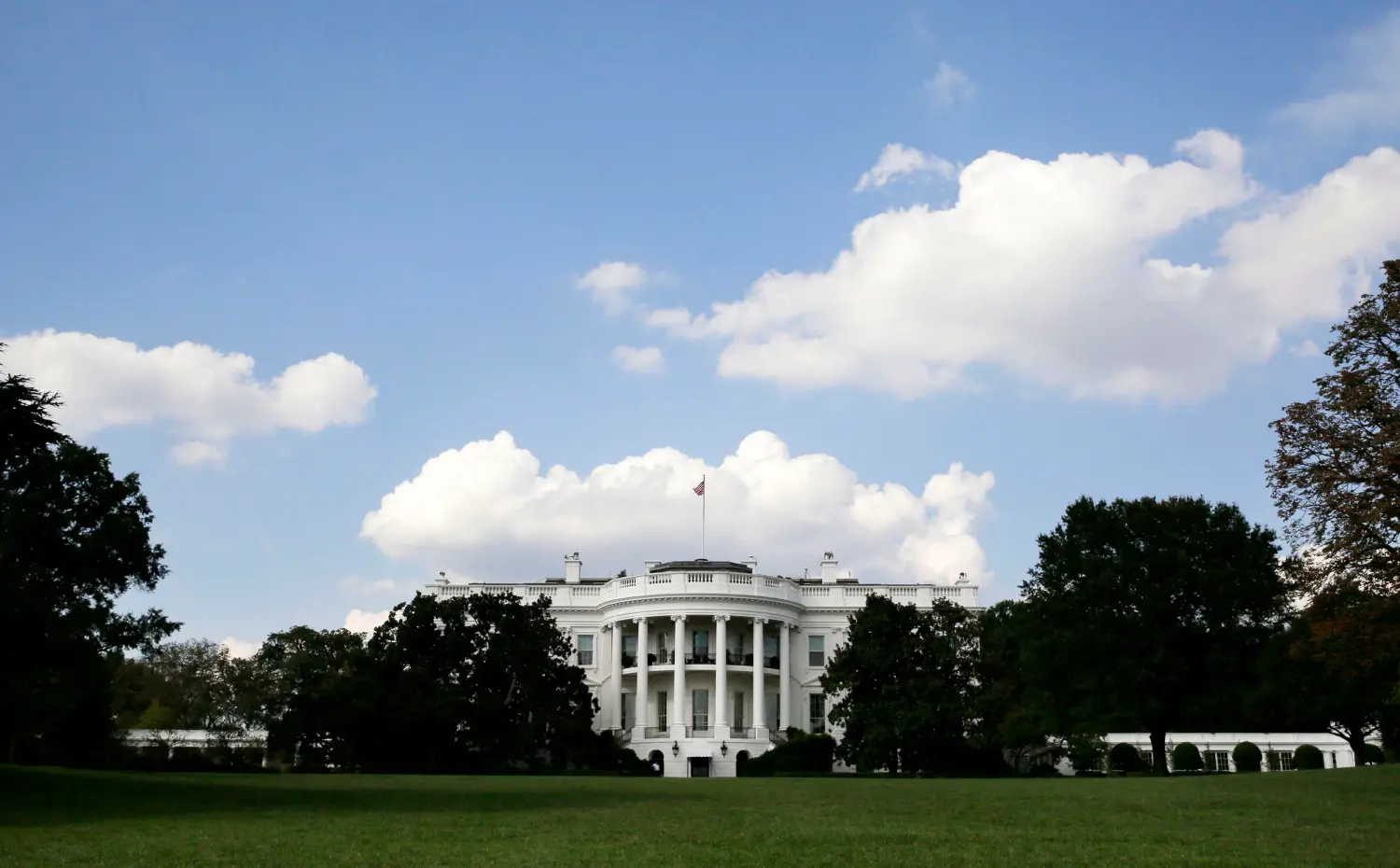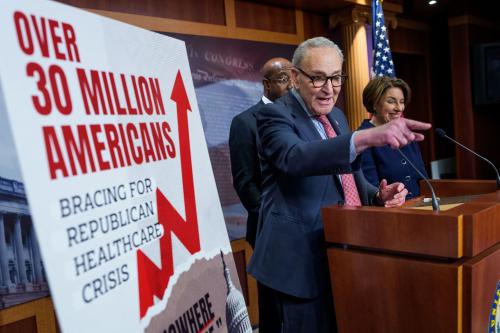Introduction: The Democrats’ choice
The 2016 presidential election gave Democrats a painful reminder that the path to the White House runs through the rough terrain of the Electoral College. Despite enjoying a popular vote margin of nearly 3 million, the Democratic ticket won only 20 states with 232 electoral votes, compared to the 30 states and 306 electoral votes won by Donald Trump and Mike Pence.
Given the party’s diverse coalition, it is anything but surprising that Democrats disagree about how to achieve a different outcome in 2020. In the best case, they would find a candidate with appeal just about everywhere, as they did in 2008. If the extraordinary voter turnout of the 2018 midterm elections is replicated in 2020, we will see the largest electorate in living memory, rendering the strategic calculations of recent decades irrelevant.
More likely, though, Democrats will have to make a choice: Should they seek to reverse their defeat in Pennsylvania, Michigan, and Wisconsin, which in 2016 supported the Republican nominee for the first time since 1988, or focus instead on the southern-tier states—Florida, Georgia, Texas, and Arizona—where long-time support for the Republican Party seems to have weakened in recent years? The former choice suggests picking a candidate with greater appeal to the voters who hold the balance of power in Pennsylvania and the upper Midwest while the latter suggests opting for a candidate better suited to energize the diverse coalitions characteristic of the South and Southwest.
The 2018 midterm election: A leading indicator?
Midterm elections often provide misleading signals about the subsequent presidential election. Republicans suffered significant losses in 1982, but Ronald Reagan was re-elected two years later in one of the greatest landslides in American history. Although Newt Gingrich’s insurgency routed the Democrats in 1994, Bill Clinton won re-election in 1996 with an enhanced margin of the popular vote. The Tea Party revolt repeated the Gingrich success in 2010, but Barack Obama nonetheless won re-election comfortably, stunning Republican nominee Mitt Romney and his senior political advisors.
But the 2018 midterm election was different, and its results shed important light on the choice that Democrats face.
Turnout in 2018 reached 49 percent, the highest for a midterm since 1966 and within two points of its all-time high in 1914. The 2018 vote was closer to a typical presidential election than to a standard midterm.
A strong midterm result usually reflects strong voter mobilization for the winning party and low enthusiasm for the loser. Here again, 2018 was different. Republican turnout rose from 40 million in 2014 to 51 million in 2018, a healthy 27 percent increase. But this growth was dwarfed by a 70 percent increase for Democrats, from 36 million to 61 million. In this way too, the strong turnout on both sides made 2018 look more like a presidential election than a midterm.
From the 2018 results to the 2020 choice
If we mine the 2018 results for guidance about the strategic choice in 2020, a clear pattern emerges. Democrats regained the ground they lost in Pennsylvania, Michigan, and Wisconsin in 2016 while winning important races in Iowa and Ohio. By contrast, attractive Sunbelt candidates failed everywhere except Arizona. These data suggest that if Democrats must choose, a Midwestern strategy has a higher probability of succeeding.
These data suggest that if Democrats must choose, a Midwestern strategy has a higher probability of succeeding.
We can analyze these results in two ways: by looking at the results of statewide races and by aggregating the results of each state’s House races. Table 1 shows the Democratic and Republican advantage in each northern-tier state’s House races (calculated by determining the total share of votes Democratic and Republican candidates received in each state) as well as the Democratic and Republican margin of victory in the 2018 Senate and gubernatorial races. (Results shaded dark blue and dark red represent races in which the Democratic or Republican advantage or margin of victory reached or exceeded ten percentage points.) Table 2 arrays comparable results for the southern-tier states.
Table 1: The northern tier
| State | House result | Senate result | Governor result |
| Iowa | D+4 | NA | R+3 |
| Michigan | D+7 | D+7 | D+10 |
| Ohio | R+5 | D+7 | R+4 |
| Pennsylvania | D+6 | D+13 | D+17 |
| Wisconsin | R+5 | D+11 | D+1 |
Table 2: The southern tier
| State | House result | Senate result | Governor result |
| Arizona | D+1 | D+2 | R+14 |
| Florida | R+8 | R+0 | R+0 |
| Georgia | R+8 | NA | R+1 |
| Texas | R+3 | R+3 | R+13 |
Note: The House calculation includes votes for Democratic candidates running in races where they faced no Republican opponent as well as votes for Democratic and Republican candidates in uncontested races. The House analysis excludes uncontested races in Florida since the state does not count votes cast for uncontested candidates.
As this simple tabulation shows, Democrats did well throughout the northern-tier states we analyzed, prevailing in seven of nine statewide races, including all six in the three states—Pennsylvania, Michigan, and Wisconsin—that proved decisive for Donald Trump’s candidacy. In the southern tier, by contrast, Democrats lost six of seven statewide races. Similarly, Democrats won the aggregate House vote in three of the five northern states but just one of four southern states.
In the northern states, Democratic House candidates flipped seats in Iowa, Michigan, and Pennsylvania, wresting control of eight of the region’s sixty congressional districts (roughly 13 percent) from Republicans. The results for Democrats in the southern states were less positive. While several Democratic House candidates managed to win seats previously held by Republican representatives in every southern-tier state analyzed, Democrats ultimately only flipped six of the 86 congressional districts analyzed (roughly seven percent).
The breadth of Democrats’ success in the northern tier was striking. Without exception, they won outright victories among white college graduates while cutting into Republicans’ advantage among white working-class voters. Democratic senatorial and gubernatorial candidates prevailed in several counties that shifted from Obama in 2012 to Trump in 2016, and even won counties that didn’t vote for Obama in 2012.
Table 3: Democratic success in northern-tier states
| State | Obama-Trump counties | Obama-Trump counties won by the Democratic gubernatorial candidate in 2018 | Obama-Trump counties won by the Democratic Senate candidate in 2018 |
| Iowa | 32 | 5 | NA |
| Michigan | 12 | 6 | 5 |
| Ohio | 8 | 1 | 7 |
| Pennsylvania | 3 | 3 | 2 |
| Wisconsin | 23 | 7 | 14 |
Note: Obama-Trump counties were colored dark red if over 30 percent of the state’s counties voted for Obama in 2012 and Trump in 2016. Obama-Trump counties won by Democratic gubernatorial and Senate candidates were colored dark blue if the Democratic candidate won at least 50 percent of the Obama-Trump counties.
Depressed African-American turnout in 2016 was a key contributor to Hillary Clinton’s losses in Wisconsin and Michigan. Here again, the 2018 results were encouraging for Democrats. In predominantly African-American Milwaukee County, the Democratic vote total rose from 230,997 in the 2014 gubernatorial race to 262,124 in 2018, a gain of 13 percent. In predominantly African-American Wayne County (Detroit), the Democratic gubernatorial total increased from 320,021 in 2014 to 463,703 in 2018, a gain of 45 percent. By contrast, the Republican total in Wayne County rose by only four percent from 2014 to 2018, and it fell by six percent in Milwaukee. Replicating these asymmetrical gains in 2020 would be more than enough to shift Wisconsin and Michigan back into the Democratic column.
The southern-tier strategy: A closer look
Kyrsten Sinema’s victory marked the first time a Democrat had won an election for an open Senate seat in Arizona since 1976, leading one Democratic strategist to declare that, “investment in Arizona and the Sunbelt is sort of crucial for opening up new opportunity for presidential campaigns.” In Texas, by contrast, despite smashing fund-raising records, Beto O’Rourke’s vigorous challenge to Ted Cruz fell short, as did Florida Senate incumbent Bill Nelson’s campaign for re-election. Despite running energetic gubernatorial campaigns in Florida and Georgia that excited progressives nationwide, Andrew Gillum and Stacey Abrams also went down to defeat.
The Florida temptation
Although the results in Florida were especially disappointing for Democrats, they should not have been entirely surprising.
Although the results in Florida were especially disappointing for Democrats, they should not have been entirely surprising. After all, Republicans had won the two previous gubernatorial elections, each by a margin of about one percentage point, in line with Ron DeSantis’s edge over Gillum. In presidential elections, moreover, Florida is always slightly more Republican than the country as a whole. In 2000, George W. Bush received 47.9 percent of the national popular vote but 48.9 percent in Florida. In 2004, he got 50.7 percent nation-wide and 52.1 percent in Florida. In 2008, John McCain totaled just 45.7 percent of the national vote against Barack Obama but 48.1 percent in Florida. In 2012, the figures for Mitt Romney were 47.2 percent and 49.1 percent, respectively. And in 2016, Donald Trump received 49.0 percent of Florida’s vote, compared to just 46.1 percent nationally. Over the past five elections, in short, Republican presidential candidates have outperformed their national totals in Florida by an average of 1.9 points, and the margin seems to be rising.
Newly released voter data provide additional insight into the 2018 results in Florida. Although African-American, Latino, and young adults turned out in droves for Andrew Gillum, a surge of white voters for his opponent was enough to keep the statehouse in Republican hands. More registered Florida Republicans than registered Democrats turned out, even though Democrats outnumber Republicans on the voter rolls. An analysis by University of Florida political scientist Dan Smith found that turnout in some Republican counties hit presidential levels. And even though public support for Trump’s re-election has fallen in many states, Floridians remain evenly split on the question.
Nor are demographic trends in Florida especially favorable for Democrats. Whites moving to Florida tend to be prosperous, conservative-leaning retirees. Many of the state’s Latinos are open to Republican candidates who reach out to them, as Rick Scott did especially well in his razor-thin victory over Bill Nelson, winning 45 percent of the Latino vote (DeSantis did almost as well, with 44 percent). On the other hand, Florida voters’ decision to return voting rights to ex-felons seems likely to work in the Democrats’ favor moving forward, even though turnout among this group may be low at first.
In a strong Democratic year—such as 2008, when Barack Obama prevailed nationally by seven points—the Democratic presidential nominee will probably prevail in Florida as well. In a tighter contest, however, the odds shift significantly in the other direction.
Jumping the gun in Texas
Texas may well end up in the Democratic column someday—but probably not in 2020. In 2018, Texas Democrats lost both the Senate and the aggregate House vote by three points, and the governorship by 13 points. Taking a longer view: Barack Obama lost the state by 12 points in 2008 and 16 points in 2012. Hillary Clinton did better but still fell short by nine points. Texas Democrats won their last statewide victory more than three decades ago, in 1988.
Texas may well end up in the Democratic column someday—but probably not in 2020.
As in Florida, moreover, Texas’ growing Latino population has long been open to Republican candidates. Despite the anti-immigrant tone of his campaign, Donald Trump received 34 percent of the state’s Latino vote. Two years later, Ted Cruz got 35 percent, and the GOP’s successful gubernatorial candidate racked up 42 percent. Although the extended controversy over the wall may weaken President Trump’s hand in 2020, even the selection of Beto O’Rourke as their presidential nominee would leave Democrats with an uphill climb in the Lone Star state.
Georgia: Peach or pit?
Stacey Abrams’ near-miss in the 2018 Georgia gubernatorial race spurred Democrats’ hopes (shared by Hillary Clinton’s campaign) that the state’s changing culture and demography is setting the stage for victory in 2020. As in Texas, these hopes have surged ahead of the facts on the ground. Republicans won the aggregate statewide House by eight points in 2018 despite a record turnout of Democratic voters. Barack Obama lost the state by five points in 2008 and by eight points in 2012. Despite a serious effort in 2016, Hillary Clinton failed to improve on Obama’s 2008 margin. The last Democrat to win a statewide race in Georgia was Zell Miller in 2000, and he was so conservative that he ended up keynoting the 2004 Republican convention.
A closer look at the 2018 gubernatorial race highlights the Democrats’ uphill climb in statewide Georgia races. Stacey Abrams did a terrific job of mobilizing voters, raising the Democratic total from 1.14 million in 2014 to 1.92 million—a gain of 778,000. But her opponent successfully counter-mobilized voters, raising the Republican total from 1.34 million in 2014 to 1.98 million—a gain of 633,000. Amazingly the two-party vote for governor in 2018 was virtually equal to the two-party presidential vote in 2016, making these results the equivalent of a dry-run for 2020.
The bottom line: A Democratic candidate with broad-based support might be able to eke out a narrow victory in 2020, but a rerun of Stacey Abrams’ campaign (Kamala Harris against Donald Trump, for example) seems unlikely to reverse the results of the 2018 gubernatorial race.
Taking a longer view
The 2018 election, however, offers just a snapshot of how these two sets of states may vote in 2020. What does a longer-term perspective reveal?
Table 4: House elections in northern- and southern-tier states
| 2012 | 2014 | 2016 | 2018 | |
| State | House result | House result | House result | House result |
| Iowa | D+3 | R+8 | R+9 | D+4 |
| Michigan | D+5 | D+2 | R+1 | D+7 |
| Ohio | R+4 | R+20 | R+16 | R+5 |
| Pennsylvania | D+2 | R+11 | R+4 | D+6 |
| Wisconsin | D+2 | R+6 | D+4 | R+5 |
| 2012 | 2014 | 2016 | 2018 | |
| State | House result | House result | House result | House result |
| Arizona | R+9 | R+16 | R+10 | D+1 |
| Florida | R+6 | R+12 | R+9 | R+8 |
| Georgia | R+18 | R+17 | R+21 | R+8 |
| Texas | R+19 | R+27 | R+20 | R+3 |
The overall performance of Democratic House candidates in Iowa, Michigan, Ohio, and Pennsylvania was noticeably stronger this past election than in the 2014 midterms. Democrats achieved a majority of votes cast for House candidates in Iowa, Michigan, and Pennsylvania while cutting the Republicans’ advantage in Ohio from 20 points to just five. Although House Democrats also made substantial gains in the four southern-tier states we analyzed, they remained well behind in Florida, Georgia, and Texas while gaining the narrowest possible advantage in Arizona.
Table 5: Senate elections in northern- and southern-tier states
| 2012 | 2018 | |
| State | Senate result | Senate result |
| Iowa | NA | NA |
| Michigan | D+21 | D+7 |
| Ohio | D+5 | D+7 |
| Pennsylvania | D+9 | D+13 |
| Wisconsin | D+6 | D+11 |
| 2012 | 2018 | |
| State | Senate result | Senate result |
| Arizona | R+4 | D+2 |
| Florida | D+13 | R+0 |
| Georgia | NA | NA |
| Texas | R+16 | R+3 |
With the exception of Sen. Debbie Stabenow (Mich.), all the senators up for re-election in the northern-tier states we analyzed surpassed their 2012 margins of victory, with Pennsylvania Sen. Bob Casey and Wisconsin Sen. Tammy Baldwin significantly improving on their 2012 performance.
In the Sunbelt, a comparison of the 2012 and 2018 Senate elections shows just how good the story was for Democrats in Arizona with Sinema’s victory and in Texas with O’Rourke’s narrow defeat. The comparison also reveals just how bad the story was for Democrats in Florida with Bill Nelson underperforming by 13 points in 2018.
Table 6: Gubernatorial elections in northern- and southern-tier states
| 2014 | 2018 | |
| State | Governor result | Governor result |
| Iowa | R+22 | R+3 |
| Michigan | R+4 | D+10 |
| Ohio | R+31 | R+4 |
| Pennsylvania | D+10 | D+17 |
| Wisconsin | R+6 | D+1 |
| 2014 | 2018 | |
| State | Governor result | Governor result |
| Arizona | R+12 | R+14 |
| Florida | R+1 | R+0 |
| Georgia | R+8 | R+1 |
| Texas | R+20 | R+13 |
An analysis of gubernatorial races in the northern tier shows Democrats’ re-emerging strength in the region. Michigan and Wisconsin saw a surge of support for the Democratic candidate for Governor this past election, as voters favored the Democratic challenger by a wide margin in Michigan and a smaller margin in Wisconsin. In Pennsylvania, Democrat Tom Wolf handily won his re-election campaign. Meanwhile, the states that voted for Republican governors did so less enthusiastically. Iowa’s incumbent Governor Kim Reynolds markedly underperformed her predecessor’s 2014 race, while Ohio’s new Republican Governor, Mike DeWine did 27 points worse than his Republican predecessor John Kasich in 2014.
The story was more mixed in the southern tier. On the one hand, Democratic challengers significantly improved over their party’s 2014 results in Georgia and Texas. On the other hand, Democrats made no progress in Florida and Arizona, and none of the Republican gubernatorial candidates went down to defeat.
Conclusion
Looking forward to 2024 and 2028, a southern-tier strategy may well prove feasible, as what has been called a “coalition of transformation” (millennials, minorities, and college-educated whites) becomes strong enough to challenge the Republican grip on these traditionally red states. And this may prove to be a smart long-term strategy in the Electoral College as the population of states throughout the Sunbelt is expected to grow more rapidly than in the northern-tier states.
Looking forward to 2024 and 2028, a southern-tier strategy may well prove feasible, as what has been called a “coalition of transformation” (millennials, minorities, and college-educated whites) becomes strong enough to challenge Republican grip on these traditionally red states.
But with the 2020 presidential election less than two years away, the party’s future does not seem to be arriving fast enough. Even in the strong Democratic tide last year, with exciting, well-organized, and well-funded candidates, Democrats lost all but one of the key statewide races in the southern-tier states we analyzed, and the statewide House vote remained unfavorable in nearly every state.
If the Democratic candidate were to win a popular vote margin as large as Barack Obama’s in 2008, he or she might prevail in some of these states, and the party would be spared the need for a strategic choice. But it would be more prudent for Democrats to plan on a tighter contest and to choose the course most likely to yield victory in less advantageous circumstances.
Our analysis suggests that reclaiming Pennsylvania, Michigan, and Wisconsin offers Democrats the path of least resistance. The 2018 election results show that Donald Trump’s victory in these states did not mark their permanent realignment into the Republican column and that Democrats attuned to the electorates of these states can prevail. There is good reason to believe that a suitable Democratic nominee could replicate this result in 2020.
The Democratic path to victory is straightforward: take enough states out of Trump’s 2016 column to reach 270 electoral votes in 2020. If our analysis is sound, the Democratic Party should look to Pennsylvania, Michigan, and Wisconsin for the electoral votes it needs to prevail, focusing on bringing voters in these states back into the Democratic fold. Anything more would be frosting on a very sweet cake for Democrats.
The Brookings Institution is a nonprofit organization devoted to independent research and policy solutions. Its mission is to conduct high-quality, independent research and, based on that research, to provide innovative, practical recommendations for policymakers and the public. The conclusions and recommendations of any Brookings publication are solely those of its author(s), and do not reflect the views of the Institution, its management, or its other scholars.
The Brookings Institution is committed to quality, independence, and impact.
We are supported by a diverse array of funders. In line with our values and policies, each Brookings publication represents the sole views of its author(s).







